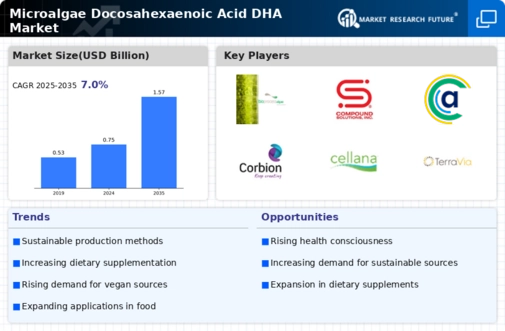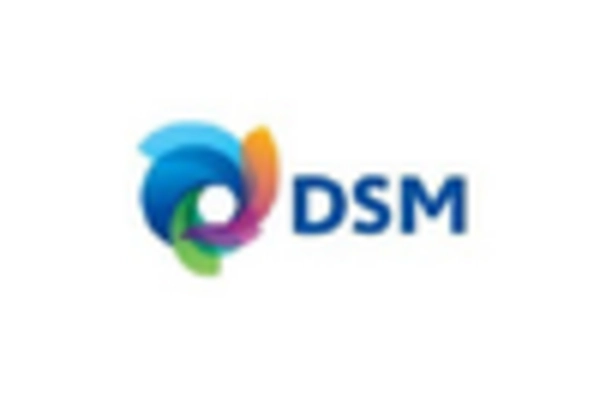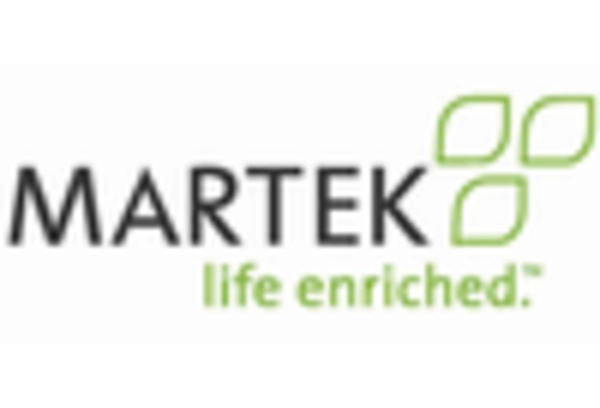Rising Health Consciousness
The increasing awareness of health and wellness among consumers appears to be a primary driver for the Microalgae Docosahexaenoic Acid DHA Market. As individuals seek to enhance their diets with nutrient-rich supplements, the demand for DHA derived from microalgae is likely to rise. Research indicates that DHA plays a crucial role in brain health, cardiovascular function, and overall well-being. Consequently, the market for microalgae DHA is projected to expand, with estimates suggesting a compound annual growth rate of over 10% in the coming years. This trend reflects a broader shift towards preventive healthcare, where consumers prioritize dietary sources of essential fatty acids, thereby bolstering the microalgae DHA market.
Environmental Sustainability Initiatives
The growing emphasis on environmental sustainability is a crucial driver for the Microalgae Docosahexaenoic Acid DHA Market. As consumers become more environmentally conscious, they are increasingly seeking products that align with sustainable practices. Microalgae cultivation is recognized for its low environmental footprint compared to traditional fish farming, making it an attractive alternative for DHA production. Market trends indicate that consumers are willing to pay a premium for sustainably sourced products, which could lead to increased market penetration for microalgae DHA. This alignment with sustainability not only appeals to eco-conscious consumers but also positions the microalgae DHA market favorably in a competitive landscape.
Growing Vegan and Vegetarian Populations
The rise in vegan and vegetarian lifestyles is significantly influencing the Microalgae Docosahexaenoic Acid DHA Market. As more individuals adopt plant-based diets, the need for alternative sources of DHA becomes increasingly apparent. Traditional sources, such as fish oil, are not suitable for those avoiding animal products. Microalgae DHA offers a sustainable and ethical solution, appealing to this demographic. Market data suggests that the plant-based supplement sector is experiencing robust growth, with projections indicating that the demand for microalgae-derived DHA could increase by 15% annually. This shift not only supports dietary preferences but also aligns with environmental sustainability goals, further driving market expansion.
Regulatory Support for Omega-3 Fatty Acids
Regulatory bodies are increasingly recognizing the health benefits of omega-3 fatty acids, including DHA, which is likely to bolster the Microalgae Docosahexaenoic Acid DHA Market. Guidelines and recommendations from health organizations advocating for higher omega-3 intake could lead to increased consumer awareness and demand. Furthermore, favorable regulations surrounding the production and labeling of microalgae-derived products may enhance market growth. Data indicates that regions with supportive regulatory frameworks are experiencing faster adoption rates of omega-3 supplements, including those derived from microalgae. This regulatory environment could facilitate market entry for new players and stimulate innovation within the sector.
Innovations in Extraction and Processing Technologies
Technological advancements in the extraction and processing of microalgae are likely to enhance the efficiency and yield of DHA production, thereby impacting the Microalgae Docosahexaenoic Acid DHA Market positively. Innovations such as supercritical fluid extraction and enzymatic processes are being developed to optimize the extraction of DHA while minimizing environmental impact. These advancements could lead to reduced production costs and improved product quality, making microalgae DHA more accessible to consumers. Market analysts suggest that as these technologies mature, the overall market for microalgae DHA may witness a surge in both supply and demand, potentially increasing market share in the broader omega-3 supplement category.


















Leave a Comment